This year's page introduces the new feature of field trip photo albums. Where you see this button
Spider Collector's Journal (15th page: 2005) Copyright © 2005 by Rod Crawford
As explained on the first page, most of these notes of fun
(and not so fun) trips to collect spiders for research at the Burke
Museum appeared in Scarabogram, newsletter of "Scarabs:
The Bug Society," in their original forms. References to the editor
mean me; most other persons mentioned are Scarabs members. Dates of field
trips head each paragraph. Maps showing the location of sites within Washington
state follow the grid system outlined in the Washington
Spider Checklist. RETURN TO INDEX
This year's page introduces the new feature of field trip photo albums. Where
you see this button
![]() in a field trip account, click
it to get a page of collecting site photos!
in a field trip account, click
it to get a page of collecting site photos!
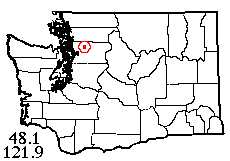 |
27 II 2005: Mercer Island high school student Jeff Benca is not your average kid. He rears and breeds mantids, snakes, cockroaches - and now spiders. He had been corresponding with yr editor about getting started with local spiders and I suggested a field trip, taking advantage of the early spring (or dry, sunny late winter). Not wishing to go too far on his first trip, I selected an area east and north of Granite Falls whence I had a partial sample already. We started almost on time, February 27; my friend Della came along to provide a picnic lunch. Once in the area, we wasted an hour driving around to various approaches to the 2 alternate collecting sites I'd picked. All gated. Quizzed at the meeting, Scarab Pehling confirmed that all logging roads in his neighborhood had been gated several years ago because of a huge illegal dumping problem. Finally we decided to park and walk a ways up the road that crosses river-sized Canyon Creek on the way to Mud Lake and Twin Lakes. These goals were too far, but I had in mind a tiny pond located near a side road not quite 2 miles walk from the gate. On the way, we passed 2 dead cows dumped by the wayside - gating hasn't entirely stopped it! The little pond, when reached, didn't look promising habitat-wise since the hillsides went steeply down to the water. It was getting late, so we settled on a secluded forested roadside on a blocked road in the vicinity. Sifting of alder litter and of moss were both productive, and several species were added from conifer and understory foliage. A big bag of maple leaf litter down by the Canyon Creek bridge added remarkably little, but the day's catch together with samples from years ago totaled 30 species. Updating one's local knowledge is also worthwhile.
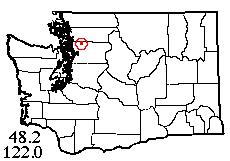 |
6 III 2005: Web-publication of the Spider Collector's Journal had a
side effect of putting me back in touch with old caving friend Larry McTigue,
who was mentioned in one of the older reports. He proposed that we go somewhere
together again for old times' sake. By combining my spider coverage map with
the map of limestone outcrops in the "cave-hunter's bible," Danner's Limestone
Resources of Western Washington, I located a spot that would interest both
of us, an area south of Stimson Hill northeast of Arlington with 3 known bodies
of limestone and unsampled for spiders.
Arrived in the area
in good time on the pleasant morning of March 6, we parked at an expected gate
and hiked to where we hoped a trail to the old Bryant limestone quarry started.
A new clearcut stood in our way, and that new clearcut was literally crawling
with non-native blackberry vines! After a thorny half hour, we discovered that
we could have missed most of the blackberries had we only hiked up a newer road...
After a few more detours we actually succeeded in tracking down our quarry,
probably abandoned at least 40 years ago.
The quarry floor
had thickish deposits of leaf litter from the alder trees high above, and plenty
of rocks to turn over, so I stayed busy there while Larry looked around for
non-manmade holes. He found that too much of the limestone had been taken out
to leave anything cavey. We left this site and followed a recently blazed, amateur
hiking trail on up the steep hillside to a saddle at 1280' elevation, where
the topo map showed a nice wetland and the actual terrain revealed another clearcut
- likewise with blackberries but not as many and only one of the two species
found below. A nice conifer foliage sample was taken from the planted Douglas-firs,
and the elusive wetland (or part of it) turned out to be in the adjacent woods,
along a stream unmarked on the map. Additional species were taken there in moss
and understory for a total of 32 from the area. The most interesting were Scironis
tarsalis, a Sphagnum-moss endemic, from a small patch of Sphagnum
by the wetland, and a very unusual wolf spider (like Pardosa dorsuncata
but too early and too dark) in the high clearcut. We met a local resident driving
a sort of jeep-scooter who was looking for his lost dog, and warned us about
cougars, but didn't seem to make the connection...
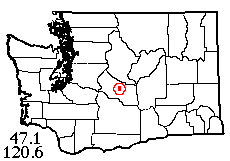 |
![]() 23 III 2005: My visiting friend Markku Savela, nature photographer from
Finland (see his
web site), had been itching to get into the field for a week but weather
and car trouble intervened. Finally we got to eastern Washington with botanical
artist Louise Smith on March 23, after a very late start because someone who
shall be nameless overslept. A couple of closer places having been rejected
as having nothing in bloom, we reached Green Canyon northwest of Ellensburg
without incident and found several species of tiny, early spring flowers blooming
near the upper limits of steppe land, sufficient to keep Markku and Louise happy.
Meanwhile, I stayed a little higher, just inside the forest zone, and sifted
some very interesting spiders (possibly including a new species or two) from
the Populus litter. It had evidently been very cold here, and hardly
any spiders were in vegetation or under rocks. When combined with the yield
from a big bag of willow litter brought back for the Berlese funnel, and 4 live
immatures to rear (of which 2 later matured), I totaled 23 spider species, which
is not bad at all for only 3 hours collecting. Besides plants, Markku photographed
a very pretty endomychid beetle, Aphorista laeta. The specimen brought
back for ID had several phoretic mites on its ventral side.
23 III 2005: My visiting friend Markku Savela, nature photographer from
Finland (see his
web site), had been itching to get into the field for a week but weather
and car trouble intervened. Finally we got to eastern Washington with botanical
artist Louise Smith on March 23, after a very late start because someone who
shall be nameless overslept. A couple of closer places having been rejected
as having nothing in bloom, we reached Green Canyon northwest of Ellensburg
without incident and found several species of tiny, early spring flowers blooming
near the upper limits of steppe land, sufficient to keep Markku and Louise happy.
Meanwhile, I stayed a little higher, just inside the forest zone, and sifted
some very interesting spiders (possibly including a new species or two) from
the Populus litter. It had evidently been very cold here, and hardly
any spiders were in vegetation or under rocks. When combined with the yield
from a big bag of willow litter brought back for the Berlese funnel, and 4 live
immatures to rear (of which 2 later matured), I totaled 23 spider species, which
is not bad at all for only 3 hours collecting. Besides plants, Markku photographed
a very pretty endomychid beetle, Aphorista laeta. The specimen brought
back for ID had several phoretic mites on its ventral side.
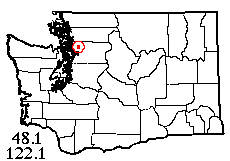 |
![]() 2 IV 2005: Markku had time for one more trip before returning home, but
weather, vehicles, and personal schedules were uncooperative. Finally I suggested
that if he just wanted to get out somewhere, he could help me take two homeless
cats (their owner had died recently) up to the Purrfect
Pals shelter in the Smokey Point area, and perhaps he could photograph a
few flowers at nearby Wenberg State Park if there was a break in the weather.
I spent an hour with the shelter cats while he tried this, only to learn that
to even park at the park cost more money than he was willing to pay! So we headed
off together to cruise the neighborhood for possible sites - completely without
maps of any kind. After another hour's tour of the Marysville-Arlington neighborhood,
meeting gates, blackberry thickets, and private property on every hand, I spotted
a promising roadside pulloff just off highway 9, (locality determined by GPS)
where I found some great maple leaf litter I could sift and some pretty blue
beetles (Altica ambiens) for Markku to photograph. Having done so, he
spotted an opening in the blackberries across the road and found a trail that
amazingly led down to a completely natural streamside, with big cedars and maples
and several plants (including salmonberry, skunk cabbage, trillium and bleeding
heart) in bloom, also some good banana slugs, and rain-forest-like moss for
me to sift. And it didn't start raining again until dusk, so we ended the day
fairly happy. However, the big bag of maple litter I brought home because it
was full of spiders proved remarkably undiverse. I never saw so many Zygottus
corvallis (a native 1.5-mm microspider) in my life, there must have been
over 100!
2 IV 2005: Markku had time for one more trip before returning home, but
weather, vehicles, and personal schedules were uncooperative. Finally I suggested
that if he just wanted to get out somewhere, he could help me take two homeless
cats (their owner had died recently) up to the Purrfect
Pals shelter in the Smokey Point area, and perhaps he could photograph a
few flowers at nearby Wenberg State Park if there was a break in the weather.
I spent an hour with the shelter cats while he tried this, only to learn that
to even park at the park cost more money than he was willing to pay! So we headed
off together to cruise the neighborhood for possible sites - completely without
maps of any kind. After another hour's tour of the Marysville-Arlington neighborhood,
meeting gates, blackberry thickets, and private property on every hand, I spotted
a promising roadside pulloff just off highway 9, (locality determined by GPS)
where I found some great maple leaf litter I could sift and some pretty blue
beetles (Altica ambiens) for Markku to photograph. Having done so, he
spotted an opening in the blackberries across the road and found a trail that
amazingly led down to a completely natural streamside, with big cedars and maples
and several plants (including salmonberry, skunk cabbage, trillium and bleeding
heart) in bloom, also some good banana slugs, and rain-forest-like moss for
me to sift. And it didn't start raining again until dusk, so we ended the day
fairly happy. However, the big bag of maple litter I brought home because it
was full of spiders proved remarkably undiverse. I never saw so many Zygottus
corvallis (a native 1.5-mm microspider) in my life, there must have been
over 100!
7 VI 2005:
The brief visit to the Arlington roadside site with Markku produced only 18
species in the end, so I took advantage of another errand to Purrfect Pals with
friend Della to revisit the site. Forty minutes in the rain, sweeping understory
in the dry spots under cedar trees, boosted the total to 24 - including 5 nonnative
species, though.
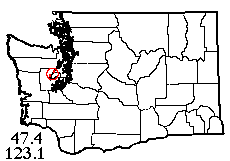 |
![]() 19 VI 2005: After a long wet spell, the prediction for Sunday was mostly
sunny. Having tried various options, I reached one good prospect for a field
trip: Liz Robinson, a Seattle math teacher and nature photographer whom I'd
met last fall over a spider found in their summer home near Lilliwaup on the
west shore of Hood Canal. Liz was agreeable to a trip to their old family homestead,
so bright and not too early Liz, her husband Chris, dog Hawkeye and I started
out.
19 VI 2005: After a long wet spell, the prediction for Sunday was mostly
sunny. Having tried various options, I reached one good prospect for a field
trip: Liz Robinson, a Seattle math teacher and nature photographer whom I'd
met last fall over a spider found in their summer home near Lilliwaup on the
west shore of Hood Canal. Liz was agreeable to a trip to their old family homestead,
so bright and not too early Liz, her husband Chris, dog Hawkeye and I started
out.
The rustic but comfortable
house on Little Lilliwaup Creek has extensive grounds, partly trashed biologically
by blackberry and other invasive plants, but some of it reasonably natural,
with a few large cedars left by the old loggers. A buttercup meadow yielded
several species, the shrubs around the house several more; across the creek
we found large trees with good moss to sift (didn't yield much, as it turned
out) and forest understory ferns and herbs to sweep. Chris found in a foxglove
a mating pair of the flower crab spider Misumena vatia which remained
together for hours to the delight of the photographers. This species is so dimorphic
that the male can and does ride around for days on the female's abdomen! Pitfall
traps in the meadow produced nothing, but one late wolf spider wandered onto
Liz's net! A pile of old roof shakes had many spiders in the lower layers, alas
few of them mature, but a Zelotes and a rearable Calymmaria were
added to the list, for a total of 24 outdoor species from the grounds.
Next we tried a
small but nice sedge salt-marsh at the mouth of the creek. This habitat usually
has unique species, but I guess we were too late for them, and got only a few
tiny immature orbweavers, plus one additional jumping spider species found by
Liz on the highway bank. A twilight visit to a forested part of the property
on the hill above the creek found some more natural habitats with little blackberry.
The most interesting spiders of the trip were taken here from conifer foliage
and the salal-manzanita-huckleberry understory, including 5 species specific
to the Kitsap heath-shrub community, plus the first western Washington record
of the gorgeous little Euryopis formosa. At dusk we had dinner and after
dark we sought house spiders by flashlight, finding three species, all European,
including Steatoda triangulosa which is mainly found in eastern Washington
houses; I was expecting the more common "false black widow," S. grossa.
Total from Little Lilliwaup Creek, 35 spider species.
I also took this
opportunity to add to a previous 18-species sample from the Hamma Hamma River
area just north of Lilliwaup. A brief visit to a highway-side site gave 7 species
to the sweep net and 2 house spider species on a wooden retaining wall, for
a new total of 27 in that area, including range extensions of introduced spiders.
Thanks to Liz and Chris for a very useful trip.
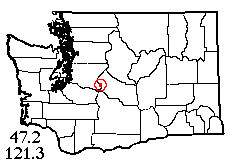 |
 |
 |
26 VI 2005: Last August, I'd collected
around Stampede Pass (just southeast of Snoqualmie Pass), more to visit my friend
Jacque at the isolated weather station than for the too-late-in-the-season spiders.
But having almost got an adequate sample, I wanted to go back this year
to supplement it. A brief break in the damp summer weather on June 26 made our
opportunity, and we (Fred and Jerry Austin and I) arrived at Lizard Lake (named
for a salamander, according to Jacque) at mid-day. I quickly got 12 spider species
from conifer foliage and 4 more from Sitka alder litter beside the lake. Sweeping
a sedge marsh in one corner of the lake, I found to my surprise that it included
a small Sphagnum bog. Fred and Jerry found several species active (including
a male Habronattus oregonensis jumping spider with his Popeye-like front
leg tibiae), and Jerry swept a few more from the roadside verge. Total for the
site, 25 species, more than we got all day last August and making over 30 for
the area.
Trying to get the
most bang for our gas money, we then headed for another partially sampled area
on the west side of Lake Kachess. I'd picked out a hilltop that seemed to have
a natural bald. On hiking up a poor logging road to the site, it turned out
to be an old clearcut which wasn't planted and is growing back in prairie-like
vegetation, but there might have been a small natural bald originally. Conifer
foliage, a large rotten stump, and ground surface active were the most productive
habitats. The best spider was a large unknown Cybaeus, found under a
log, which I successfully reared; Fred and Jerry each added one very beautiful
species to the list, Poecilochroa columbiana and Euryopis formosa.
Then, hidden in the forest, we found a panoramic viewpoint where someone had
constructed a nice bench among the rock outcrops! A few more species were taken
below the hilltop in a willow swamp. It had been getting colder and windier,
and started to rain just as we reached the car. Twenty species here for the
day, making 30 with previous records.
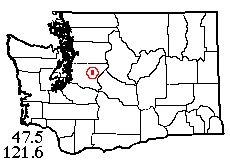 |
![]() 3 VII 2005: Lindsay Rogers and her friend Melody are charming graduate
students of Prof. Greta Binford (first arachnologist to colonize the Portland
area) at Lewis and Clark College. Greta and her students are studying the venom
and evolution of haplogyne spiders, a group with 6 (instead of 8) eyes and primitive
anatomy represented by only a few species in the Northwest. One of those species
is the telemid Usofila pacifica, a tiny inhabitant of leaf litter with
a remarkable blue-green abdomen (see album) which
seems to reproduce parthenogenically - hundreds of females have been found and
only 3 or 4 males. I had agreed to help Lindsay and Melody find some live Usofila
for DNA studies, but hadn't known they'd schedule the trip on the 4th of July
weekend - although I'd never collected a Usofila in July before! (They
are commonest in October). I picked an area which, from the Landsat photomap
of King County, should have plenty of maple leaf litter, best habitat for the
spider, and we arrived on schedule just after noon at an un-named tributary
of the Middle Fork Snoqualmie River, accompanied by Jerry Austin, Lindsay's
mother (Prof. Margaret Rogers of the UW Speech department) and their dog Sadie.
Contrary to weather predictions it was a beautiful sunny day. Leaf litter proved
very satisfactory both in quality and spider content, and actually produced
two immature Usofila - very tiny things to hope to get any DNA out of,
but Greta seems hopeful - and 11 other spider species, unusually good for a
summer litter sample, including the rare Walckenaeria atrotibialis. Another
interesting (though not uncommon) species found was Dirksia cinctipes,
an agelenoid that makes no web but wanders on vegetation, and has a red pattern
instead of the brown usual for the group. Between us, Jerry and I got 27 spider
species at the site in no more than 3 hours. And the professor treated everyone
to shakes and burgers in North Bend.
3 VII 2005: Lindsay Rogers and her friend Melody are charming graduate
students of Prof. Greta Binford (first arachnologist to colonize the Portland
area) at Lewis and Clark College. Greta and her students are studying the venom
and evolution of haplogyne spiders, a group with 6 (instead of 8) eyes and primitive
anatomy represented by only a few species in the Northwest. One of those species
is the telemid Usofila pacifica, a tiny inhabitant of leaf litter with
a remarkable blue-green abdomen (see album) which
seems to reproduce parthenogenically - hundreds of females have been found and
only 3 or 4 males. I had agreed to help Lindsay and Melody find some live Usofila
for DNA studies, but hadn't known they'd schedule the trip on the 4th of July
weekend - although I'd never collected a Usofila in July before! (They
are commonest in October). I picked an area which, from the Landsat photomap
of King County, should have plenty of maple leaf litter, best habitat for the
spider, and we arrived on schedule just after noon at an un-named tributary
of the Middle Fork Snoqualmie River, accompanied by Jerry Austin, Lindsay's
mother (Prof. Margaret Rogers of the UW Speech department) and their dog Sadie.
Contrary to weather predictions it was a beautiful sunny day. Leaf litter proved
very satisfactory both in quality and spider content, and actually produced
two immature Usofila - very tiny things to hope to get any DNA out of,
but Greta seems hopeful - and 11 other spider species, unusually good for a
summer litter sample, including the rare Walckenaeria atrotibialis. Another
interesting (though not uncommon) species found was Dirksia cinctipes,
an agelenoid that makes no web but wanders on vegetation, and has a red pattern
instead of the brown usual for the group. Between us, Jerry and I got 27 spider
species at the site in no more than 3 hours. And the professor treated everyone
to shakes and burgers in North Bend.
 |
![]() 17 VII 2005: A previous trip to Liars Prairie
on the headwaters of Jungle Creek, Teanaway River drainage, netted an interesting
but inadequate sample due to a short stay and too-advanced season. Thanks to
Jeff Benca (see first 2005 trip above), we had the chance to try it again. My
friend Della came along for the ride and provided one of her toothsome lunches. The
day was beautiful and we arrived at the site with few glitches. The meadow was
very dry, as on the previous trip, but determined sweeping still netted 7 species,
with a further 8 from conifer foliage (grand fir mostly). The best habitat was
wood fragments and logs in the surrounding forest, where Jeff and I got 8 additional
species (some of them rare) and 2 cool centipedes. A new Grammonota was
taken under a rock, and additional species were found in fir litter and among
the active wolf spiders. In the dry surroundings, it was refreshing to find
the very moist ravine of the Jungle Creek headwaters, where a not-yet-identified
Pityohyphantes sheetweb weaver was among the additions. The bark of a
large Ponderosa pine produced nothing, but we got 27 species for the day plus
2 live immatures being reared (one already molted, 2 days later). In all, quite
a successful trip for mid-summer. It helped that we had no time limit and were
able to collect until dusk; having a helper also helped! Sunglow behind the
mountains beautified our trip home.
17 VII 2005: A previous trip to Liars Prairie
on the headwaters of Jungle Creek, Teanaway River drainage, netted an interesting
but inadequate sample due to a short stay and too-advanced season. Thanks to
Jeff Benca (see first 2005 trip above), we had the chance to try it again. My
friend Della came along for the ride and provided one of her toothsome lunches. The
day was beautiful and we arrived at the site with few glitches. The meadow was
very dry, as on the previous trip, but determined sweeping still netted 7 species,
with a further 8 from conifer foliage (grand fir mostly). The best habitat was
wood fragments and logs in the surrounding forest, where Jeff and I got 8 additional
species (some of them rare) and 2 cool centipedes. A new Grammonota was
taken under a rock, and additional species were found in fir litter and among
the active wolf spiders. In the dry surroundings, it was refreshing to find
the very moist ravine of the Jungle Creek headwaters, where a not-yet-identified
Pityohyphantes sheetweb weaver was among the additions. The bark of a
large Ponderosa pine produced nothing, but we got 27 species for the day plus
2 live immatures being reared (one already molted, 2 days later). In all, quite
a successful trip for mid-summer. It helped that we had no time limit and were
able to collect until dusk; having a helper also helped! Sunglow behind the
mountains beautified our trip home.
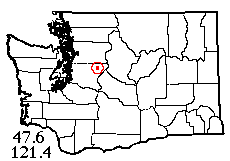 |
![]() 24 VII 2005: Delightful weather had me wishing for a field trip, and
Santa Claus appeared in the form of Markku Savela from Finland (close enough
to the North Pole), back in town and wanting to photograph flowers and butterflies
for his web site.
I had found the West Fork of Miller River a likely prospect in map scouting:
remote, unspoiled, varied vegetation and rocky slopes, in a north-draining canyon
that should still be fairly moist in the dry season. All this turned out correct,
but there were a few things I hadn't bargained on. The road shown on the topo
map is long since undriveable and a de-facto hiking trail - not really a problem
since we're both able-bodied enough to hike the necessary mile. Spider season
was way too far advanced for collecting at 1800', though, and over 5 hours of
hard work collecting from understory, moss, maple litter, river rocks, conifer
foliage and logs gave me only 11 identifiable species. Many other tantalizingly
attractive specimens turned out to be immature. Markku fared a little better,
but not many plants were in bloom and the butterflies were going too fast to
shoot. I'll have to go back - preferably after fly season! The fly family Rhagionidae
is not as familiar as deer flies or mosquitoes, but is occasionally abundant
along rivers - as in this case. They are not very good at biting, but are more
than willing to have a try at it! See the album page
for a photo. On the plus side, the hiking was very pleasant (except where the
"trail" was washed out and bouldery) and extremely scenic, with the
rushing river, small waterfalls, spectacular cliffs (one near our collecting
site had a rock-climber's rope on it - see album)
and a few spectacular old-growth trees. I'll be back!
24 VII 2005: Delightful weather had me wishing for a field trip, and
Santa Claus appeared in the form of Markku Savela from Finland (close enough
to the North Pole), back in town and wanting to photograph flowers and butterflies
for his web site.
I had found the West Fork of Miller River a likely prospect in map scouting:
remote, unspoiled, varied vegetation and rocky slopes, in a north-draining canyon
that should still be fairly moist in the dry season. All this turned out correct,
but there were a few things I hadn't bargained on. The road shown on the topo
map is long since undriveable and a de-facto hiking trail - not really a problem
since we're both able-bodied enough to hike the necessary mile. Spider season
was way too far advanced for collecting at 1800', though, and over 5 hours of
hard work collecting from understory, moss, maple litter, river rocks, conifer
foliage and logs gave me only 11 identifiable species. Many other tantalizingly
attractive specimens turned out to be immature. Markku fared a little better,
but not many plants were in bloom and the butterflies were going too fast to
shoot. I'll have to go back - preferably after fly season! The fly family Rhagionidae
is not as familiar as deer flies or mosquitoes, but is occasionally abundant
along rivers - as in this case. They are not very good at biting, but are more
than willing to have a try at it! See the album page
for a photo. On the plus side, the hiking was very pleasant (except where the
"trail" was washed out and bouldery) and extremely scenic, with the
rushing river, small waterfalls, spectacular cliffs (one near our collecting
site had a rock-climber's rope on it - see album)
and a few spectacular old-growth trees. I'll be back!
 |
![]() 30 IX 2005: On the 9th day of fall, my friend Della had rented a car
for an evening errand in Fall City, and we decided to combine it with a day
collecting trip. In view of uncertain weather, I planned to head for the other
side of Snoqualmie Pass and try collecting on the Cle Elum River downstream
from Cle Elum Reservoir. My new volunteer Kate Turner went along to assist.
We arrived at our site, near a footbridge across the river, just as a school
group was leaving. A pile of hay bales, left by the Game Department for migrating
elk, was nearby. It turned out to be a bridge to nowhere (fenced halfway across)
but the vicinity of the near side had some good habitats, including conifers
to beat and lots of rocks to look under. A solitary cottonwood tree produced
some litter which mixed with the abundant fir/pine litter could be sifted for
spiders - the sifting had to proceed under a tree when it started to sprinkle.
Kate continued working the rocks and got a good collection in her first attempt
at spider field work. After it started to rain in earnest around 4:30, we looked
around the neighborhood for a bigger stand of cottonwoods, finding one with
little trouble, and I filled a garbage bag with pure deciduous litter for later
processing in the Berlese funnel. The results of the trip far exceeded expectations,
including several bizarre-looking species I didn't even recognize!
30 IX 2005: On the 9th day of fall, my friend Della had rented a car
for an evening errand in Fall City, and we decided to combine it with a day
collecting trip. In view of uncertain weather, I planned to head for the other
side of Snoqualmie Pass and try collecting on the Cle Elum River downstream
from Cle Elum Reservoir. My new volunteer Kate Turner went along to assist.
We arrived at our site, near a footbridge across the river, just as a school
group was leaving. A pile of hay bales, left by the Game Department for migrating
elk, was nearby. It turned out to be a bridge to nowhere (fenced halfway across)
but the vicinity of the near side had some good habitats, including conifers
to beat and lots of rocks to look under. A solitary cottonwood tree produced
some litter which mixed with the abundant fir/pine litter could be sifted for
spiders - the sifting had to proceed under a tree when it started to sprinkle.
Kate continued working the rocks and got a good collection in her first attempt
at spider field work. After it started to rain in earnest around 4:30, we looked
around the neighborhood for a bigger stand of cottonwoods, finding one with
little trouble, and I filled a garbage bag with pure deciduous litter for later
processing in the Berlese funnel. The results of the trip far exceeded expectations,
including several bizarre-looking species I didn't even recognize!
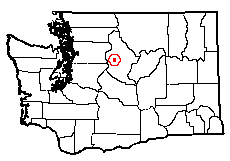 |
![]() 16 X 2005: Energized by the good stuff found last month, I wanted to
try another eastern Washington fall trip. It's a good way to get out of unsuitable
western Washington weather, too! Kate liked spider collecting so much that she
was eager to go again, so on the next weekend with a decent forecast, we headed
for Lake Wenatchee (after a slight delay caused by my cat Macavity's preoccupation
with a fresh-caught rat). I wanted to try an area of little ponds and wetlands
at the west end of the lake, but the no-trespassing signers had been at work
there. Fortunately we found a nearby spot on the White River with far more reasonable
no-vehicles and no-littering signage. The area was beautiful with fall colors
(see album) and included a huge grass meadow and
open riparian woodland of cottonwood, red cedar, and grand fir. A lot of sweeping
in the meadow produced only a few spiders so I settled down to sift cottonwood
litter for most of the day, while Kate collected under logs. Spiders were sparse
in the litter but good (19 species), and conifer foliage also yielded well;
between us we got 34 species for the day including at least one new. Weather
remained pleasant, with occasional refreshing blasts of wind not lasting long
enough to interfere with collecting. On the way home we ran into rain again
just before Stevens Pass, feeling happy at our decision to head for the east
side.
16 X 2005: Energized by the good stuff found last month, I wanted to
try another eastern Washington fall trip. It's a good way to get out of unsuitable
western Washington weather, too! Kate liked spider collecting so much that she
was eager to go again, so on the next weekend with a decent forecast, we headed
for Lake Wenatchee (after a slight delay caused by my cat Macavity's preoccupation
with a fresh-caught rat). I wanted to try an area of little ponds and wetlands
at the west end of the lake, but the no-trespassing signers had been at work
there. Fortunately we found a nearby spot on the White River with far more reasonable
no-vehicles and no-littering signage. The area was beautiful with fall colors
(see album) and included a huge grass meadow and
open riparian woodland of cottonwood, red cedar, and grand fir. A lot of sweeping
in the meadow produced only a few spiders so I settled down to sift cottonwood
litter for most of the day, while Kate collected under logs. Spiders were sparse
in the litter but good (19 species), and conifer foliage also yielded well;
between us we got 34 species for the day including at least one new. Weather
remained pleasant, with occasional refreshing blasts of wind not lasting long
enough to interfere with collecting. On the way home we ran into rain again
just before Stevens Pass, feeling happy at our decision to head for the east
side.
 |
![]() 20 XI 2005: On the unsuccessful (but scenic) collecting trip to the West
Fork of the Miller River in July (see above), I noticed a curious thing, a trailside
rock face on the side away from the river that had the sound of roaring water
coming from it! This was enough to interest my old caving friend Larry McTigue
in a return trip, even though he suspected it would turn out to be just an echo.
After many delays due to bad weather, we finally made it back on November 20.
And after all that time waiting for nice weather, everything was still wet.
Evidently there had been snow that had melted, and heavy dew on top of that.
The trail was just as boulder-covered as before, but somehow didn't seem so
bad this time and we reached my collecting site (after disposing of Rod's Infamous
River Echo in short order) quickly. Spiders in the leaf litter were so cold
they just weren't moving, so I finally gave up on sifting and brought back a
bag to Berlese-funnel. Sifting moss was considerably more productive, and collecting
from logs also netted a few spiders of interest. Tree-beating was dismal (wet,
and produced only the same 2 species I got in July). In search of more habitats,
we hiked on up the trail to a huge, landmark cedar tree where a side trail takes
off for the historic King and
Kinney Mine. At this point there was some remnant snow on the ground - also
the grave (or at least a memorial cross) at the spot where a hiker had died
a few years ago.
20 XI 2005: On the unsuccessful (but scenic) collecting trip to the West
Fork of the Miller River in July (see above), I noticed a curious thing, a trailside
rock face on the side away from the river that had the sound of roaring water
coming from it! This was enough to interest my old caving friend Larry McTigue
in a return trip, even though he suspected it would turn out to be just an echo.
After many delays due to bad weather, we finally made it back on November 20.
And after all that time waiting for nice weather, everything was still wet.
Evidently there had been snow that had melted, and heavy dew on top of that.
The trail was just as boulder-covered as before, but somehow didn't seem so
bad this time and we reached my collecting site (after disposing of Rod's Infamous
River Echo in short order) quickly. Spiders in the leaf litter were so cold
they just weren't moving, so I finally gave up on sifting and brought back a
bag to Berlese-funnel. Sifting moss was considerably more productive, and collecting
from logs also netted a few spiders of interest. Tree-beating was dismal (wet,
and produced only the same 2 species I got in July). In search of more habitats,
we hiked on up the trail to a huge, landmark cedar tree where a side trail takes
off for the historic King and
Kinney Mine. At this point there was some remnant snow on the ground - also
the grave (or at least a memorial cross) at the spot where a hiker had died
a few years ago.
There are worse
places to die. This area is truly beautiful. Not a non-native species to be
seen; no humans up the trail on this nice fall day either. More of the landscape
was visible with the leaves off the trees. The canyon is so deep that the winter
sun didn't hit my collecting site until 1PM, then left it again at 2:30! There
was plenty of water in the river as well as many of the side rills and mini-waterfalls.
The end result of the spider collecting was 22 species, barely adequate but
not much to show for 2 trips - maybe this site truly has a depauperate fauna,
or maybe I just chose the wrong dates.
This page last updated 21 March, 2025